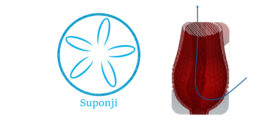Suponji

WHAT ORGANISMS/NATURAL SYSTEMS DID YOU LEARN FROM AND HOW DID WHAT YOU LEARNED INFORM YOUR DESIGN?
Taking inspiration from filter feeding organisms, our team looked at mechanisms for removing tiny particles from the water column. We investigated the filtering efficiency of a sea sponge that is able to create a uni-dimensional flow through its body and filter out particles from the water column. The sponge achieves this due to its form. A ratio of incurrent pores to the large excurrent pore creates a flow through the sponge body. We were inspired by this low-energy “pump-like” process and aspired to use it within our design. We also looked at the filtering capability of baleen, the keratin filtration system used by whales. Whales consume large amounts of water, packed with tiny but numerous amounts of krill, and using the baleen all along their jaws, are able to filter out the krill for their food. Using both of these filtration systems, we aimed to create a solution that would address the overabundant jellyfish in the sea.
WHAT IS THE PROBLEM YOU ARE TRYING TO SOLVE AND HOW IS IT RELATED TO CLIMATE CHANGE?
The reality of climate change is increasingly evident within our vast oceans. With rising temperatures and ocean acidification, as well as human-induced pollution, agricultural run-off, and overfishing, ocean ecosystems are changing drastically and natural food webs are being disrupted. Surprisingly, one group of organisms is thriving under in these changing conditions. Jellyfish are becoming increasingly abundant in the world’s oceans owing to their ability to survive in harsh environments. They are so successful that they are blooming in numbers that imbalance entire ecosystems and disrupt local fisheries. The over-abundant jellyfish have become such a problem specifically in East Asian seas, that entire fisheries have had to bring their boats ashore and give up for the season. Jellyfish blooms not only rupture fishing nets but also fill them so abundantly so that any fish catch is either too poor in number or too toxic to be put on the market. This problem is affecting people’s livelihoods, their local economy, as well as ecosystem services. Using this unique example of a species thriving under the conditions of climate change, we aim to create a bio-inspired solution that restores balance within the local ecosystem and helps local communities mitigate the impacts of climate change.
WHAT DOES YOUR DESIGN DO? HOW DOES IT ADDRESS THE PROBLEM OR OPPORTUNITY YOU SELECTED
Our design solution recognizes the unique reproductive biology of the over-abundant jellyfish and utilizes it to reduce the amount of adult jellyfish entering the ecosystem. Whereas other solutions have aimed to remove adult jellyfish from the ocean, a difficult and often more destructive solution, our team has focused on another part of the jellyfish lifecycle and aimed to reduce the frequency of blooms while jellyfish are still developing. Inspired by the passive flow of the sea sponge and the filtering capability of the whale baleen, our design filters water within ports and harbors (renowned breeding grounds for jellyfish eggs, and polyps), and removes the immature stages of the developing jellyfish before they become a problem too big to handle. At the polyp stage of the jellyfish life cycle, one polyp could give rise to thousands of adult jellyfish. This highly successful reproduction is what makes jellyfish blooms so widespread and incredibly disruptive. Under climate change, these blooms are becoming more and more frequent. Since these polyp stages move only with the water currents, our design creates a flow through a sponge-like structure and captures them within a baleen filter. The aim is not to irradicate, but to reduce.

TEAM MEMBERS
Rebecca MacKinnon, Roy van den Berg, Thimo, Devoney Angela, Raoul Schiffer

